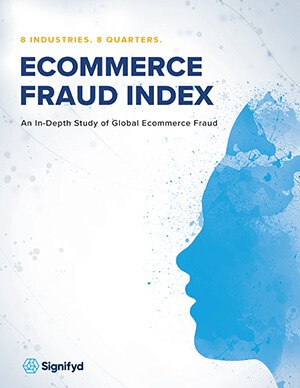
Signifyd, the world’s largest provider of guaranteed payment fraud protection, today released its Ecommerce Fraud Index, which analyzed global data from billions of transactions across thousands of merchants.
The data covers an eight-quarter period from January 2016 through December 2017 and is organized across eight major ecommerce industries including alcohol/tobacco/cannabis, apparel, consumer electronics, cosmetics/perfumes, department stores, furniture/appliances/home improvement, health/leisure/hobbies, and jewelry/watches/precious metals.
According to the report, total fraud losses increased 7 percent from 3.80 percent in 2016 to 4.0 percent in 2017. Losses during the holiday season were higher, with fraud increasing 24 percent from 3.07 percent in Q4 2016 to 3.83 percent in Q4 2017.
The beauty industry was hit hard, with fraud increasing 102 percent for online cosmetics and perfume retailers from 2.52 percent in 2016 to 5.10 percent in 2017. Online department stores also struggled, with fraud losses increasing 48 percent from 1.47 percent in 2016 to 2.18 percent in 2017.
Losses from account takeover fraud increased 80 percent from 0.25 percent in 2016 to 0.45 percent in 2017. Account takeover fraud occurs when a fraudster logs in as an existing user on a merchant’s site and uses pre-existing payment options to place purchases, usually shipped to a new address.
For online department stores, account takeover fraud increased a whopping 285 percent, from 0.06 percent in 2016 to 0.23 percent in 2017, representing more than 10 percent of total fraud losses. For jewelry and luxury watch merchants, account takeover fraud increased 194 percent, from 0.42 percent in 2016 to 1.24 percent in 2017.
Through data analysis and hundreds of interviews with merchants, Signifyd noticed the following ecommerce fraud prevention trends.
Merchants Rejecting Legitimate Orders Due to Delivery Address Bias
- Over time, fraud prevention teams at merchants can develop a bias for delivery addresses, ZIP codes, cities, or even entire regions that just don’t “feel” right.
- Merchants using static rules based on ZIP codes, or relying too heavily on delivery addresses, are rejecting legitimate orders and losing revenue to false positives.
Larger Merchants Evolving Fraud Defenses Faster
- Larger merchants outperform their smaller counterparts with higher acceptance rates and lower fraud losses.
- As merchants grow, they attract more experienced fraud prevention experts.
- These experts are better equipped to test new technologies and apply multiple methodologies, such as machine learning and liability shift options.
Popular Products and Flash Sales Susceptible to Fraud
- When merchants with popular products increase their marketing efforts, they may inadvertently be driving consumers to fraudsters offering these products on Amazon or eBay.
- One example of product fandom that creates spikes in fraud are flash sales for limited edition items. Such flash sales are common in the cosmetics and apparel industries, where thousands of units will sell out in minutes.
- For merchants without machine learning, accepting thousands of orders in minutes can lead to hours of manual reviews and a great deal of chargebacks for fraudulent orders accepted during the flash sale rush.
Determining fraud as an individual merchant is a daunting task. Fraudsters hope merchants will act alone, with only the data available to them from each transaction. This works to the fraudster’s advantage. For this reason, there is no lone wolf strategy for cybersecurity. Whenever possible, merchants should leverage the data and intelligence of peers in their industry, or in the case of this report, thousands of merchants across numerous industries.
Signifyd provides a 100 percent financial guarantee against fraud and prevents chargebacks for thousands of online retailers. With liability for fraudulent chargebacks on a global scale, Signifyd has a first-hand view of fraud everywhere. This allows fraud analysts to see larger trends and a greater variety of threats so they can accept more orders while minimizing fraud losses.







